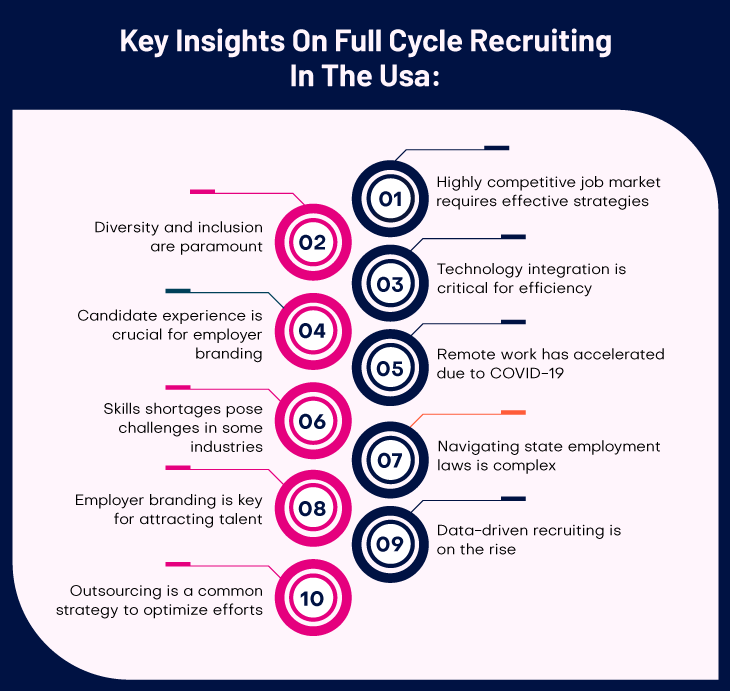Topics: Full Cycle Recruiter, Full Cycle Recruiting, Outsource Full Cycle Recruiting
Posted on September 19, 2024
Written By Sakshi Sharma

Full cycle recruiting, also known as 360-degree recruitment, is the complete hiring process – from the initial job posting to the final onboarding of a candidate. In this model, a full cycle recruiter handles every stage, providing a smooth experience for both clients and candidates.
Why is this important? Because in today’s competitive U.S. job market, mastering the full cycle recruiting process is essential for attracting top talent, boosting hiring efficiency, and enhancing the candidate experience.
In this guide, you’ll learn:
Full cycle recruitment or the full cycle recruiting process refers to the complete process of hiring journey, from identifying the need for a new hire to successfully onboarding them into the organization.
In this model, a full cycle recruiter manages every stage of the process, typically including:
This hands-on, start-to-finish approach ensures consistency in communication, faster hiring cycles, and better alignment between client needs and candidate capabilities.

Full cycle recruiting in the USA is a multifaceted process that offers several key insights into the intricacies of talent acquisition in this competitive job market. Firstly, the USA boasts a highly competitive job market across a wide range of industries, making it imperative for organizations to have effective recruiting strategies to attract and retain top talent. Secondly, diversity and inclusion have become paramount, with companies increasingly prioritizing these aspects in their hiring processes to create more inclusive workforces.
Additionally, the integration of technology plays a significant role, with applicant tracking systems (ATS), artificial intelligence (AI), and data analytics being widely used to streamline and enhance the recruiting process. The candidate experience is another critical consideration, as candidates have more choices than ever before, and negative experiences can tarnish an organization’s reputation.
The COVID-19 pandemic has accelerated the adoption of remote work, prompting recruiters to adapt to virtual interviewing and onboarding processes. Skills shortages, particularly in fields like technology and healthcare, pose a challenge, necessitating proactive efforts to identify and attract candidates with the required skill sets. Furthermore, navigating varying state-specific employment laws and regulations adds complexity to the recruiting landscape, highlighting the importance of compliance.
Employer branding has emerged as a key element for attracting talent, with companies investing in showcasing their culture and values to align with potential candidates. Data-driven recruiting is on the rise, with metrics such as time-to-fill, cost-per-hire, and quality of hire helping recruiters make informed decisions. Continuous learning and professional development are essential in this ever-evolving field. Lastly, organizations often explore outsourcing or partnering with specialized firms to optimize their full-cycle recruiting efforts.
In the midst of these insights, recruiters in the USA must remain adaptable, tech-savvy, and candidate-centric while staying attuned to market trends and continually refining their recruitment strategies to secure the best talent in this dynamic environment.

Adopting a full cycle recruitment strategy offers several advantages:
| Focus Area | Challenge | Solution |
| Time Management | Balancing sourcing, interviews, and admin work. | Use scheduling tools, prioritize tasks, and delegate admin work. |
| Tech Integration | Managing ATS, CRM, and sourcing platforms efficiently. | Choose integrated recruitment tech stacks. |
| Candidate Drop-Off | Losing talent mid-process due to delays. | Communicate regularly and shorten hiring timelines. |
| Compliance & Legal Requirements | Navigating U.S. labor laws and state-specific rules. | Partner with compliance experts or outsource parts of the process. |
Below are a few of the ways to check if your full-cycle recruitment is on track.
QX helped a staffing firm expand in the US with its full cycle recruitment model covering sourcing to onboarding. In six months, the fill rate jumped from 20% to 60%, generating $300K revenue, placing 31 hires, and cutting backout rates to under 0.5%.
At QX Global Group, we specialize in full cycle recruiting for U.S. staffing firms. From sourcing top talent to ensuring compliance and seamless onboarding, our offshore teams act as an extension of your in-house recruiters, helping you fill roles faster, cut costs, and improve quality of hire.
Full cycle recruiting in the U.S. goes beyond filling roles, it’s about creating a sustainable hiring strategy. QX’s Full Cycle Recruitment Outsourcing Services help U.S. staffing firms streamline the entire hiring process, from sourcing to onboarding, improve fill rates, reduce time-to-hire, and deliver high-quality candidates, consistently and cost-effectively.
Full-cycle recruiting is a comprehensive approach to talent acquisition that involves every stage of the recruitment process, from the initial job posting to the final onboarding of a new hire. It’s a critical function within HR and talent acquisition departments across various industries in the United States. However, for those new to the concept or looking to deepen their understanding, a set of frequently asked questions (FAQs) can serve as a valuable starting point.
In this FAQ guide, we’ll explore the fundamentals of full-cycle recruiting, breaking down its stages, differentiating it from other recruitment roles, and even delving into the advantages of outsourcing. Whether you’re an HR professional or an aspiring recruiter, these answers will help you navigate the intricacies of full cycle recruiting.
Full cycle recruiting differs from traditional recruiting because traditional models often involve multiple recruiters handling different stages, whereas a full cycle recruiter manages the entire process for consistency, efficiency, and a better candidate experience.
The skills essential for a full cycle recruiter include strong communication, sourcing expertise, time management, negotiation skills, and knowledge of recruitment technology.
Yes, full cycle recruiting can be applied to remote hiring. With virtual interviews, e-signatures, and online onboarding, the process works seamlessly for remote roles.
Industries that benefit most from full cycle recruiting include healthcare, IT, finance, manufacturing, and any sector with competitive hiring needs.
The first three steps of the 360-degree recruitment process are job requisition, job posting, and candidate sourcing. Job requisition identifies the hiring need, job posting advertises the role, and candidate sourcing finds potential applicants through various channels.
The difference between a recruiter and a full cycle recruiter is that a recruiter may focus only on sourcing or screening, while a full cycle recruiter manages the entire process from sourcing to onboarding.
The biggest advantage of outsourcing full cycle recruiting is cost efficiency. It gives companies access to specialized recruitment expertise, reduces in-house costs, and speeds up hiring.
Other terms used for full cycle recruiting include 360-degree recruiting, end-to-end recruitment, and complete recruitment. These terms describe the same comprehensive approach to hiring.
Originally published Sep 19, 2024 07:09:25, updated Aug 29 2025
Topics: Full Cycle Recruiter, Full Cycle Recruiting, Outsource Full Cycle Recruiting